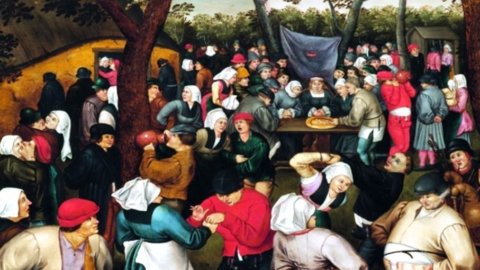The exhibition "Brueghel. Wonders of Flemish art“, hosted at Chiostro del Bramante (Rome) will remain open only until 7 July. The exhibition is by Sergio Gaddi and Doron J. Lurie, Conservator of Old Master Paintings at the Tel Aviv Museum of Art, the exhibition is part of a large international project that lands for the first time in the Eternal City in a new and renewed version, after the stops in Como and Tel Aviv.
With over 100 works, the exhibition offers the public the opportunity to see wonderful paintings up close, presented in an organic and complete way in the suggestive Capitoline setting, coming from important national and international museums, and from a large number of prestigious private collections, in the whose extremely fragmented dislocation in the world lies the exceptional nature of this exhibition which has managed to collect and put together masterpieces that would otherwise be difficult to access, some of which have never before been exhibited to the public.
An unmissable opportunity therefore to appreciate extraordinary paintings, for the first time in Italy, such as the magnificent The Seven Works of Mercy (1616 – 1618 ca.) by Pieter Brueghel the Younger, in which the various representations of charity are exalted and declined through the intensity of the portrayed figures, recalling by contrast the superb The seven deadly sins by Hieronymus Bosch (c. 1500), or The charlatan of the school of Bosch, both present in the exhibition and never arrived in Rome before.
It is precisely from the relationship that the progenitor of the Brueghels, Pieter the Elder (1525/1530 ca. – 1569) had with Bosch, begins the story of the dynasty which, with its disenchanted vision of humanity, has marked the history of European art of the centuries to come. Of the "spiritual master" Pieter Brueghel the Elder he was able to deepen the dreamlike visions in an earthly key, passing from a refined style focused on tradition, to a more icastic one interested in reality, paying great attention to the landscape and the relationship between man and nature, through scenes of peasant dances and figurative proverbs that echoed for a long time and definitively changed Flemish painting, opening it up to modernity. Illustrator of a rural world that has become a symbol of a reading on the meaning of human life which already at the time was enjoying incredible success with international clients, after his death, the comic and grotesque registers typical of his works took on an educational value which it was then collected by his sons, Pieter the Younger (1564 - 1638) and Jan the Elder (1568 - 1625).
Compared to his brother, Pieter the Younger followed in his father's footsteps more closely (also making actual copies, today sometimes the only evidence of lost originals), whose style and themes, however, he was able to renew through a personal elaboration, traceable in shows for example in the splendid Bird Trap (1605) which, with its strong atmospheres and decisive colors, embodies all the peculiarities of the Flemish Baroque. While Jan the Elder, nicknamed "of the velvets" for the preciousness of his technique, proved to be more oriented towards stylistic renewal, becoming the imitative reference for later "Brueghelian" artists.
The genealogy then continues and branches out, from the patriarch to his most distant descendants, in a complicated network of relationships presented in the exhibition with precision and rigor, up to the eleven children of Janmil Giovane, five of whom are also painters. In the middle of the 600th century, the "Brueghel style" has now taken on the features of a real quality mark. The path focuses on the events of each artist and develops according to a network logic, embracing historical references of the period in question, and analyzes the experience even of characters such as Jan van Kessel I (1626 - 1679), son of Paschasia, sister by Jan Brueghel, and by Ambrosius Brueghel (1617 - 1675), an artist of the highest quality but little known and studied. Finally, the exhibition itinerary closes with
The first section is dedicated to the historical and cultural environment within which the artistic experience of the progenitor of the entire dynasty, Pieter Brueghel the Elder, developed.
The second section it is dedicated to the sons of Pieter Brueghel the Elder: Pieter the Younger and Jan the Elder. The first, chronicler of his time, takes up his father's themes, but at the same time manages to develop and enrich them, especially in the representations of peasant scenes and everyday life.
In the third section the articulated artistic relationships that exist between the numerous members of the Brueghel genealogy and their advantageous creative collaborations with different artists are analyzed in detail, such as those between Jan Brueghel the Younger and Frans Francken, Joos de Momper or Hendrick van Balen. The "Brueghel style" has now become a
In the fourth section, we find the technique and style of Jan the Elder are taken up by his son Jan the Younger, to whom the exhibition dedicates a large space, as well as a specific thematic section relating to genre painting with explicit naturalistic reference to flowers and symbolic visions.
The fifth and final section of the exhibition completes the presentation of the more than one hundred years of activity of the Brueghel workshop, which had already become legendary since the second half of the 600s, but does not forget other great painters who entered the circle by marriage, such as David Teniers the Younger who married Anna, sister of Jan the Young, and is among the greatest storytellers of the daily peasant world of the '600, even in the absence of the severe judgments of Pieter Brueghel the Elder.
Cloister of Bramante
Via Arco della Pace – 5 – Rome
Hours info: 0668809036





